Recent Articles
Popular Makes
Body Types
2017 Hyundai Elantra First Drive
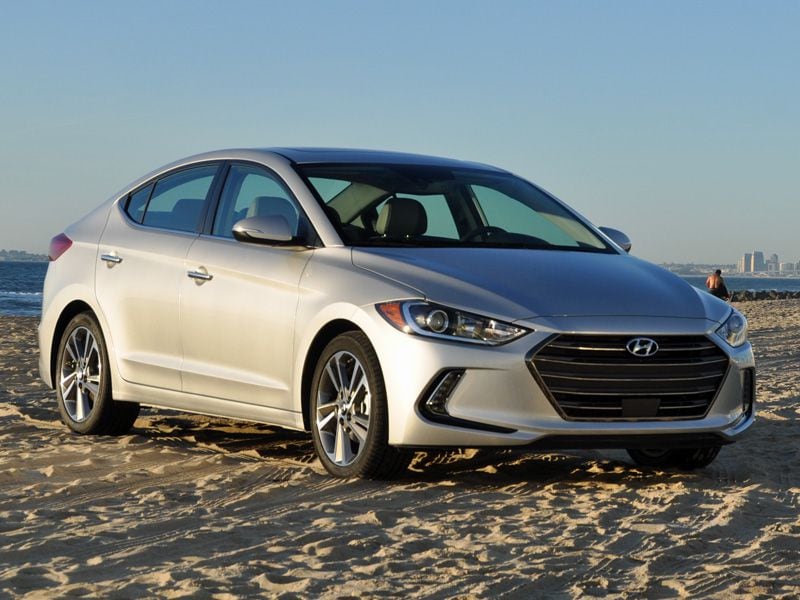
ABTL 2017 Hyundai Elantra Limited Front Quarter Right ・ Photo by Christian Wardlaw
A case study in corporate tenacity, Hyundai steadfastly benchmarks the competition, relentlessly returns to the drawing board, diligently checks every box on the to-do list, and builds an army of impressive cars and crossovers. Among the current crop of Hyundais, few fail to meet my standards for recommendation, and when I leave one off of the list, it is usually due to older engineering that can’t earn top safety ratings.
Take the redesigned 2017 Hyundai Elantra, for example. It replaces a groundbreaking vehicle that brought genuinely dramatic style to the compact car segment, a good looking, safe, and dependable automobile loaded with value. Still, Hyundai’s designers, engineers, and product planners needed to build a better one, an Elantra with improved fuel economy, greater comfort, modern technologies, and more enjoyable driving dynamics. Plus, it had to be stylish, it had to be safe, and it had to present a compelling value equation.
Having now spent a day driving and riding in the new 2017 Elantra, I’d say that Hyundai has once again checked every box on its to-do list, and then some.
Models and Pricing
Initially, the new Elantra is available in SE and Limited trim levels. By summer, a fuel-efficient Eco model will join the lineup, and Hyundai has another version planned that is sure to please driving enthusiasts.
Prices start at $17,985, but if you want an automatic transmission it will cost another $1,000. Highlights include air conditioning, cloth seats, front seat height adjusters, a tilt/telescopic steering wheel, satellite radio, a USB port, and not much else. That’s why you’re going to want the automatic transmission, which in turn makes available a very affordable Popular Equipment Package. For a mere $800, this upgrade contains aluminum wheels, automatic headlights, heated side mirrors, cruise control, and a touchscreen infotainment system with Bluetooth, a reversing camera, and smartphone projection technology in the form of Apple CarPlay and Android Auto.
At this point, the Elantra’s window sticker still reads less than $20,000. A Tech Package bumps the price to just over $21,000 and equips the car with a blind spot warning system with rear cross-traffic alert, dual-zone automatic climate control with clean air ionization, heated front seats, keyless entry with push-button engine starting, a hands-free power trunk opener, upgraded instrumentation and interior materials, slick door handle approach lighting, and more.
For a taste of luxury, the Elantra Limited delivers at a base price of $23,185. This version includes the equipment listed above, plus leather seats, a power driver’s seat, dual USB ports, and a Blue Link subscription services system. A set of 17-inch aluminum wheels also comes standard on the Limited, along with extra chrome trim, LED running lights, LED taillights, and LED turn signal indicators in the side mirror housings.
Options for the Elantra Limited include a Tech Package ($2,500), which supplies heated rear seats, an auto-dimming rearview with a programmable garage door opener, a power sunroof, and an upgraded infotainment system with a larger 8-inch touchscreen display, navigation, and an Infinity premium sound system with Clari-Fi music restoration technology.
Finally, an Ultimate Package ($1,900) adds forward collision warning with pedestrian detection and automatic emergency braking, a lane departure warning system with lane keeping assist, adaptive cruise control, adaptive HID headlights that help to illuminate around corners, and memory for the driver’s preferred settings. Install a cargo net and floor mats, and a loaded Limited comes to $27,760.
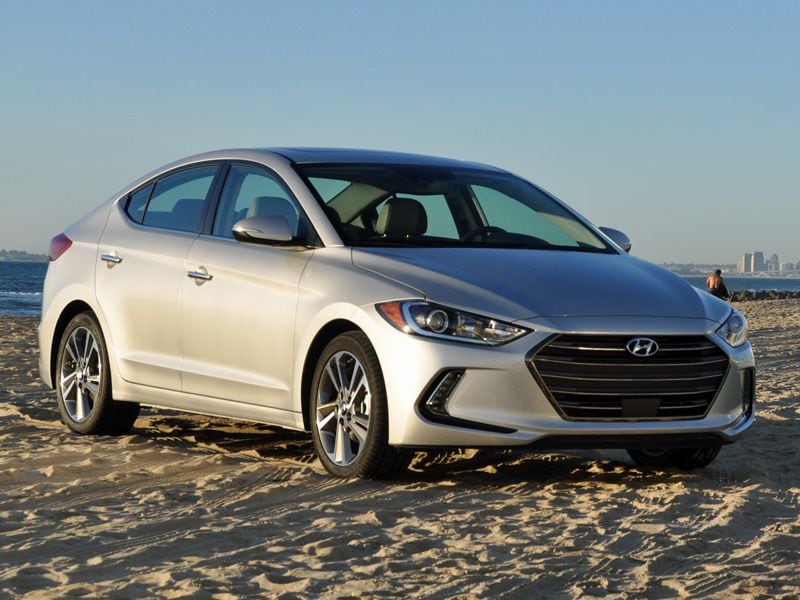
Photo by Christian Wardlaw
Exterior Design
Conservatively penned and more aerodynamic compared to the previous-generation Elantra, the new 2017 model is not as expressive yet is mighty attractive.
No matter the paint color, the Elantra Limited looks clean, contemporary, and modestly upscale. There is visual balance and harmony to this design, and in my opinion it is better executed than the larger Hyundai Sonata. Both cars are cut from the same stylistic cloth, but the Elantra is the more attractive and sophisticated of the two, and exhibits clearer ties to the 2017 Genesis G80 (the luxury sedan previously known as the Genesis).
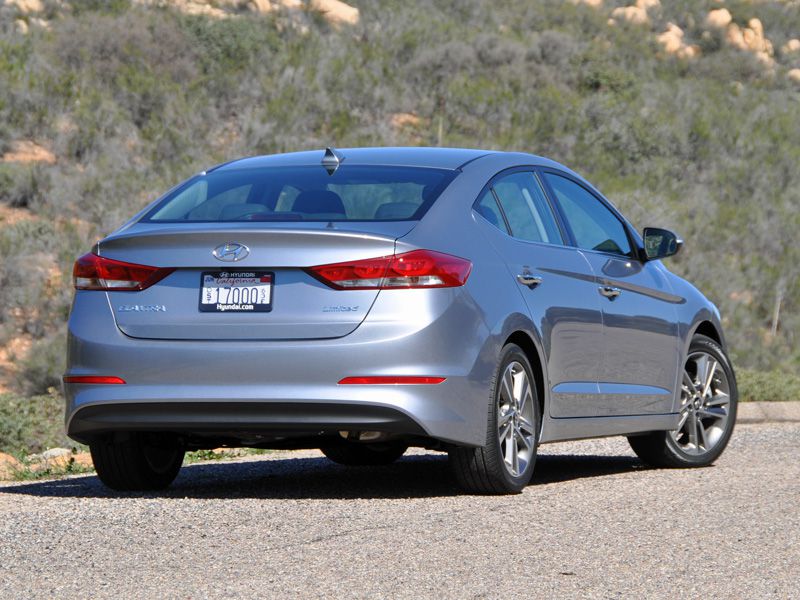
Photo by Christian Wardlaw
Interior Design
Like the Sonata, the redesigned 2017 Elantra’s cabin reflects modernity, simplicity and substance. From the soft, smooth leather wrapped around the steering wheel to how the transmission shifter feels and sounds when it is used, it is clear that Hyundai sweats the details. As a result, the interior possesses the power to impress the owner on each and every drive.
Dashboard design emphasizes width, making the Elantra feel open and spacious, and Hyundai installs lots of buttons and knobs in familiar locations to make the car’s features easier to use. Thicker glass and more sound absorption materials make the Elantra quieter, and tastefully rendered materials available in high-contrast, two-tone gray and beige interior colors lend a sense of refinement. Black interiors are, naturally, all matchy-matchy.
The only complaints I have about the new Elantra’s interior relate to the use of hard plastic on the upper portions of the door panels and on the front seat backs. In each location, soft material would enhance comfort. Otherwise, Hyundai has done an outstanding job with this cabin.
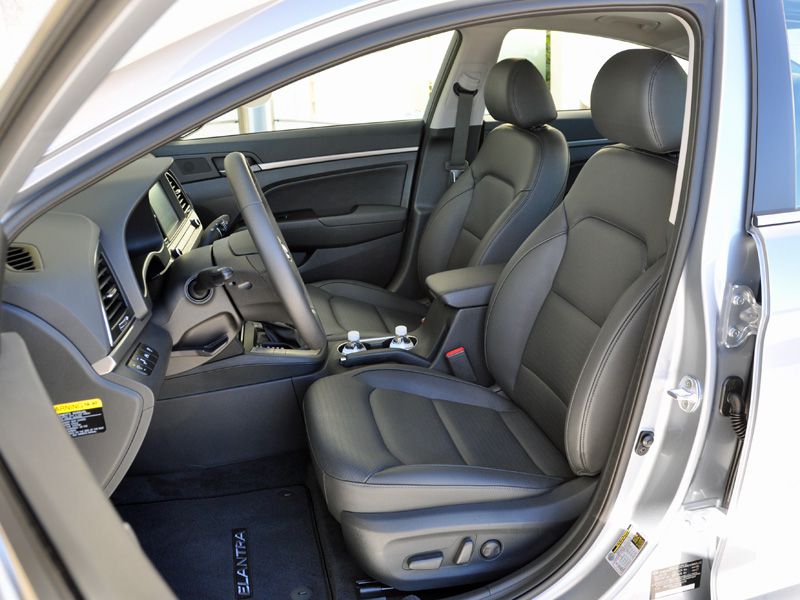
Photo by Christian Wardlaw
Interior Features
Thoughtfully, the dual-zone automatic climate control system includes a clean air ionization filter, an appreciated touch when sitting in traffic surrounded by diesel-powered pickup trucks and Harleys with illegal pipes. Heated front and rear seats are also available, but Hyundai elects not to install a heated steering wheel or ventilated front seats no matter how much money you have to spend.
A touchscreen infotainment system with a 7-inch display is included for most versions of the Elantra. It includes Apple CarPlay and Android Auto smartphone projection technology, which makes the car’s screen resemble that of your device when it is tethered to the system via the USB port. Limited models with the Tech Package have an upgraded infotainment system with navigation and a larger 8-inch touchscreen display.
An Infinity premium audio system is also available for the Limited, and includes Clari-Fi music restoration technology. “Crank up the stereo in this car,” said a Hyundai representative. “It’s awesome.” Blasting Tame Impala, I discovered that, yes, for the compact car segment, the stereo is indeed awesome.
One of the great things about the Elantra’s interior is that the infotainment systems are equipped with real buttons and real knobs, which makes it easier to use the stereo and climate controls, and to access the main menus for the car’s various systems. In a world where voice control, gesture recognition, touch panels, and virtual buttons are increasingly the norm, this nod to simplicity and refusal to try and fix what isn’t broken is a beautiful thing.
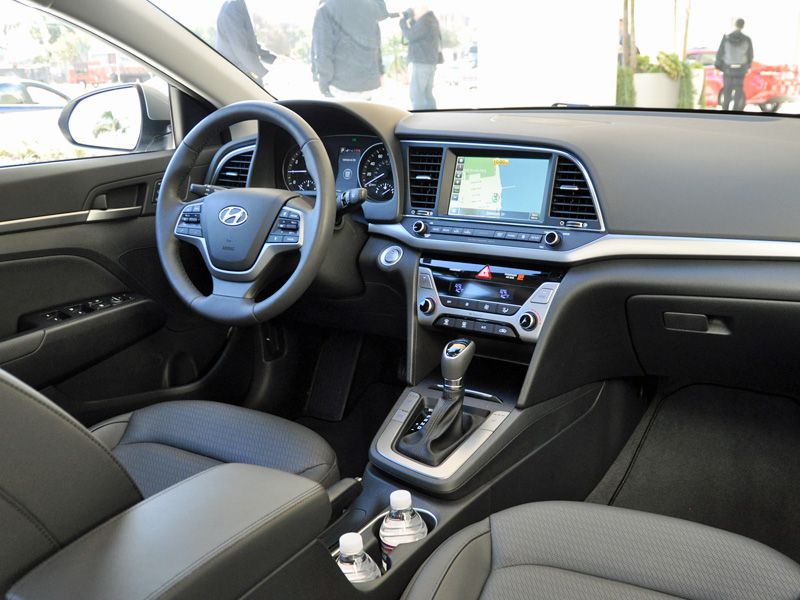
Photo by Christian Wardlaw
Comfort and Cargo
Standard equipment includes manual seat height adjusters for both the driver and front passenger, and this is a big deal in terms of comfort. Because even the least expensive Elantra provides a higher seating hip point than some competitors, it is easier to get into and out of this car, and is therefore also more comfortable.
Seat structures are designed to help reduce injury in certain kinds of collisions, and cushions employ multi-firmness soy-based foam padding that is alleged to provide better long-distance driving comfort. Having spent a significant chunk of a day as both a driver and a passenger, I can attest that the Elantra is a comfortable car over time.
My co-driver was quite tall and thin, and he fit comfortably behind the steering wheel. I’m six feet even and overweight, and I fit comfortably behind the steering wheel. With the front passenger’s seat moved all the way back in its track, I could also tuck myself into the rear seat, but my legs were in uncomfortable contact with the hard plastic front seat backs. That’s why I say they should be softly padded. Moving the front seat forward a bit really helped in terms of rear seat comfort, convincing me that four sizable people can be happy aboard the Elantra.
Trunk space measures 14.2 cu.-ft. That is not quite as generous as the leaders in the compact sedan segment, or the previous Elantra, but is roomy enough for a family of four on a weeklong road trip.
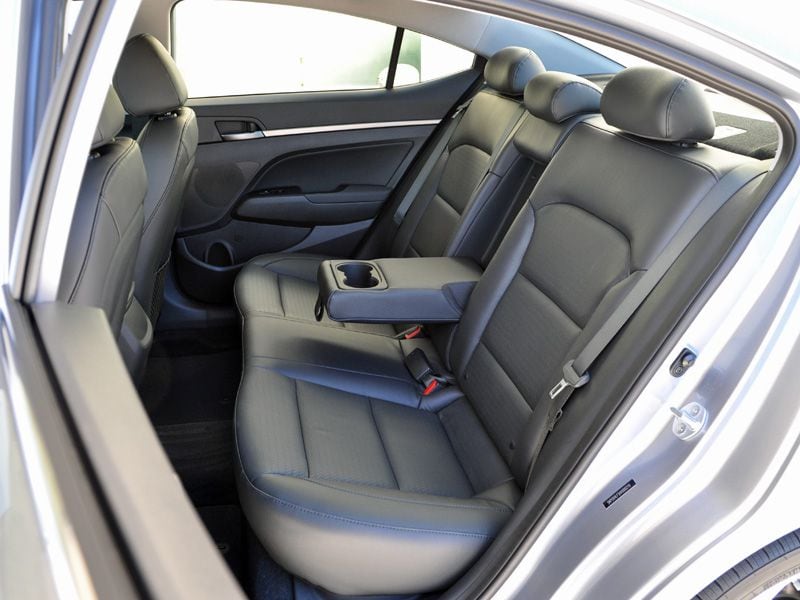
Photo by Christian Wardlaw
Safety
Engineered to earn top safety ratings, more than half of the Elantra’s architecture is constructed using high-strength steel. As this review is written, official crash testing has not been conducted, but Hyundai showed images from its internal testing that demonstrated significant resistance to structural intrusion in a frontal-impact test.
While few safety features are standard on the basic Elantra, Hyundai does offer more than just a reversing camera for this car. A blind spot warning system with lane change assist and rear cross-traffic alert is an option, as well as a lane departure warning and lane keeping assist system. A forward collision warning system with pedestrian detection and automatic emergency braking is also available.
Trouble is, unlike Honda, which democratizes similar technologies across the Civic lineup, Hyundai restricts its forward collision warning, pedestrian detection, and automatic emergency braking technologies to the most expensive version of the Elantra, the Limited with the Ultimate Package.
Limited models are also exclusively available with next-generation Blue Link subscription service, which is compatible with new Apple and Android smart watches and offers a number of useful safety features. For the first year, free of charge, the Elantra Limited is equipped with automatic collision notification and SOS emergency assistance. Upgrade to the next highest package of Blue Link service, and the Elantra includes speed, curfew, and geographic boundary alerts, which are useful to parents of teenaged drivers. A car finder service also helps parents to locate the Elantra using a smartphone application.
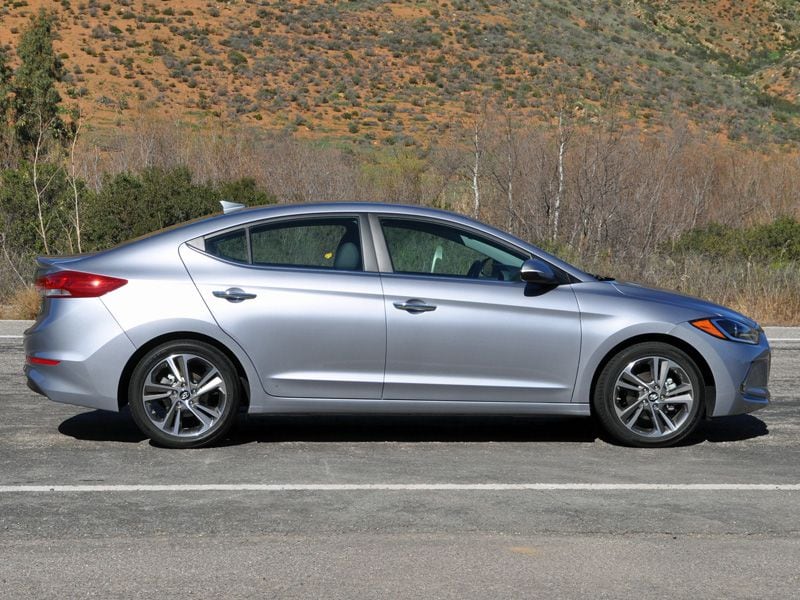
Photo by Christian Wardlaw
Engines and Fuel Economy
Initially, the only engine for the 2017 Elantra is a new, Atkinson-cycle, 2.0-liter 4-cylinder making 147 horsepower at 6,200 rpm and 132 lb.-ft. of torque at 4,500 rpm. In California and other states with strict emissions regulations, this engine is outfitted as a Partial Zero Emissions Vehicle (PZEV), and with no reduction in power output.
A 6-speed manual gearbox is standard in the Elantra SE, but few dealerships will stock this transmission. That’s OK, because the 6-speed automatic is terrific, and preferable to the continuously variable transmissions (CVT) and dual-clutch automated manual transmissions available in some competitors. Plus, the Elantra’s automatic comes with new Drive Mode Select settings including Eco, Normal, and Sport, as well as a manual shift gate with an intuitive pattern.
Versions with the automatic transmission provide better fuel economy, too. The EPA rates the manual gearbox to get 29 mpg in combined driving, while the automatic should return 32 mpg. What did I get during my drive? Not 32 mpg. Instead, I averaged 28.9 mpg, but to be honest, much of my driving was conducted on the mountainous two-lane roads east of San Diego and with the transmission in the Sport driving mode, so consider my result a worst-case scenario.
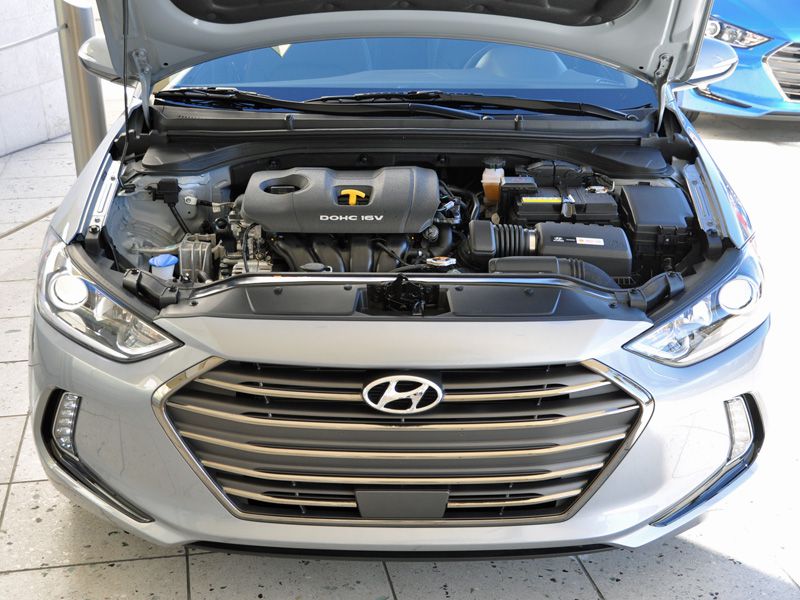
Photo by Christian Wardlaw
Performance
Quieter and more enjoyable to drive than the previous Elantra, the redesigned 2017 model makes a little more power at slightly lower rpm and weighs slightly less in base format, but the changes don’t have an appreciable impact on acceleration. Rather, the new car’s layer of extra refinement, combined with Drive Mode Select’s available Sport setting, contributes to a feeling of greater responsiveness.
While a CVT or dual-clutch transmission might produce better fuel economy, Hyundai knows that people prefer a good, old-fashioned automatic, and so that’s what is installed in the new Elantra. It works exactly as you might expect, and the manual shift gate is blissfully intuitive (move the shifter back, or down, for a downshift and move it forward, or up, for an upshift). Plus, the transmission selector’s solid, purposeful feel when choosing a gear is a small but important contributor to the Elantra’s overall sense of refinement.
Though Hyundai still uses cost-effective engineering solutions like drum rear brakes (SE models) and a torsion beam rear axle in the initial versions of the new Elantra, suspension improvements make the latter component a non-issue unless you drive the car flat out on wriggling pavement. Rear disc brakes are used for the Elantra Limited, and in combination with this trim level’s larger 17-inch aluminum wheels, handling is secure and confidence inspiring.
Better yet, on the city streets, suburban boulevards, and freeways where the new Elantra will spend the majority of its time, it impresses as a substantial automobile, one that can take a corner with ease, accelerate to speed without trouble, and effortlessly cruise at extra-legal velocities. It might not be an outright sport sedan (yet), but it is quite satisfying to drive.
There is, however, an exception, and that pertains to the car’s electric steering. Now tied to Drive Mode Select, which replaces last year’s Driver Selectable Steering Mode technology, the steering is much better than before, exhibiting more natural response and greater on-center stability. Unfortunately, I prefer the Elantra’s steering in Normal mode and the powertrain in Sport mode, which means that compromise is a part of every drive.
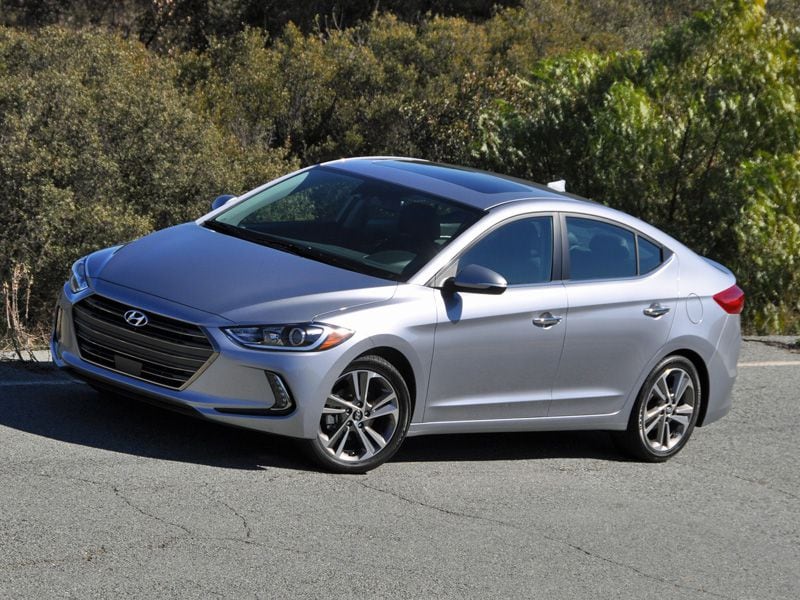
Photo by Christian Wardlaw
Final Thoughts
Hyundai’s new 2017 Elantra is a terrific car, easily landing on my recommended list.
Considering that Hyundai is no longer a discount brand, though, the company needs to make four-wheel-disc brakes standard and ought to swap out the torsion-beam rear axle suspension for an independent setup. It doesn’t matter that the typical car buyer doesn’t know or care about this stuff. If the Elantra expects to be a class-leading vehicle, it must match class leaders in terms of engineering sophistication.
Soft material for the upper door panel trim and front seatback panels would also be nice to have, and, speaking from the perspective of a parent seeking the safest possible vehicle for a family, it sure would be great if Hyundai made forward collision warning with automatic emergency braking available at a more affordable price.
Add these items to your next to-do list, Hyundai, and you might discover that you’ve created the most appealing compact car in America.
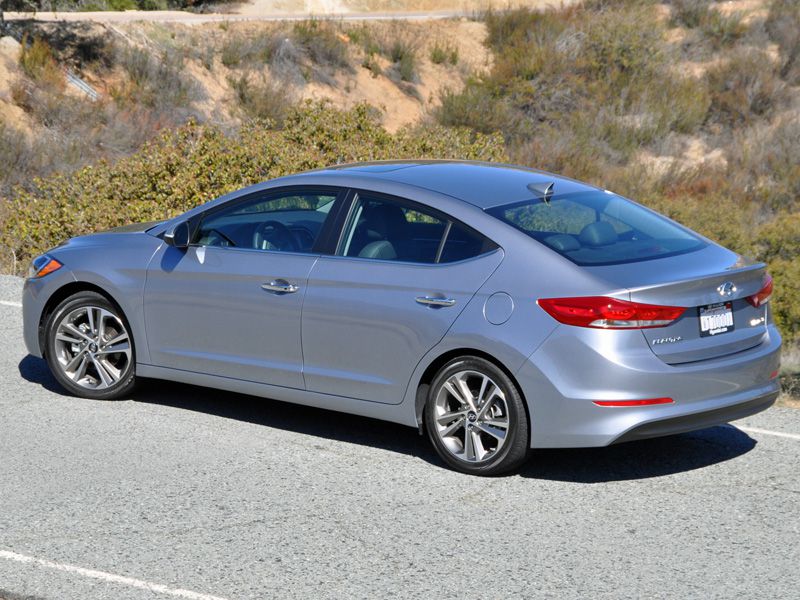
Photo by Christian Wardlaw